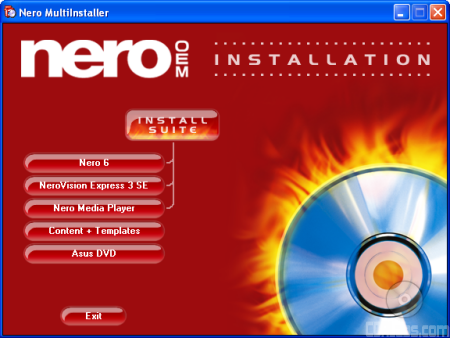Like the other ASUS drives I've reviewed, the DRW-1608P3S was very easy to install. From start to finish, the entire process took only a few minutes. I took the drive out of the box, left the jumper set to master and installed it on the secondary IDE chain by connecting the IDE cable and power connector. When I turned on the computer the BIOS detected it as a drive supporting UDMA 66. After making sure that the DMA was enabled in the Device Manager, I was ready to start installing the software.
Software Installation:
As I mentioned earlier, the DRW-1608P3S comes with two CD's full of software. The first of these contains a few different applications from Nero and ASUS. If you have autorun enabled on your computer, the menu pictured below will automatically come up when you insert the disc.
By now most of you should be pretty familiar with this menu. From here you can choose to install Nero 6,NeroVision Express 3 SE, Nero Media Player, or ASUS DVD. Simply click the name of the application you want to install, and its setup program will start up automatically. Once you reboot, you'll be ready to start burning your own discs.
The second disc contains Ulead's DVD MovieFactory 4 suite. Like the other software, the installation process is fairly straightforward. All you need to do is choose what language you want and pick your installation options.By default the setup program will install the entire suite onto your computer. If you don't want to install the entire suite, select the custom installation. From here you can choose the components you want to install.
The Documentation:
Like the DRW-1608P2, the DRW-1608P3S doesn't offer much in the way of documentation. The closest thing to a manual is the drive's "Quick Installation Guide". This small, fold out guide is broken up into 20 different languages with each language getting about a page worth of instructions. While these instructions take the user step by step through the installation process, the small diagrams keep them from being very useful. Also, if you're looking for things like the DRW-1608P3S's specs or system requirements, you'll have to check the back of the box or visit ASUS's website. You won't find that information in the guide.
While ASUS has put a lot of effort into the DRW-1608P3S's features and performance, the documentation could have been better. The brief installation instructions probably won't phase more experienced users, but they might not cut it with those new to upgrading their computer. With this in mind, I give the installation a 7 out of a possible 10.



